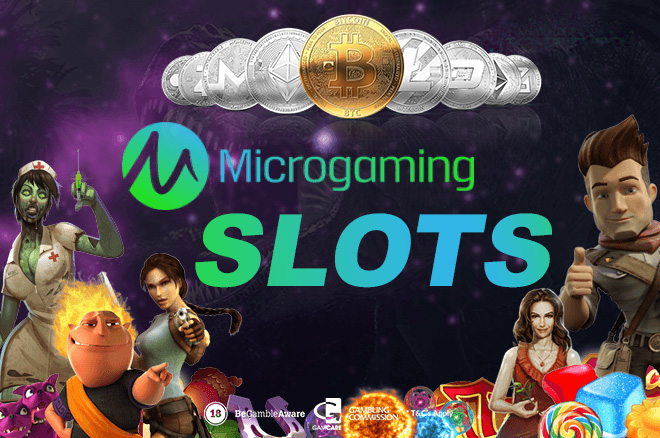| Cloudbet | FortuneJack | Bitstarz | mbit | bitcasino.io | orca88.com | 1xbet | Betcoin.ag |
| Yes | Yes | Yes | No | Yes | Yes | Yes | No |
The 10 most popular Microgaming slots 2025
| #1 | Mega Moolah |
| #2 | Immortal Romance |
| #3 | Lucky Riches |
| #4 | Thunderstruck 2 |
| #5 | Alaskan Fishing |
| #6 | Ariana |
| #7 | Six Acrobats |
| #8 | Break da Bank Again |
| #9 | Game of Thrones |
| #10 | Lost Vegas |
The 10 Microgaming Crypto Slots with the highest RTP
| Xcalibur | 97.62% |
| Wild Orient | 97.5% |
| Retro Reels | 97.5% |
| Party Island | 97.5% |
| Lucky Riches | 97.5% |
| Couch Potato | 97.43% |
| High Five | 97.43% |
| Summer Holiday | 97.14% |
| Pollen Party | 97% |
| Pretty Kitty | 97% |
Microgaming Crypto Casinos and the cryptocurrencies you can deposit with
| Cloudbet | FortuneJack | Bitstarz | bitcasino.io | orca88.com | 1xbet | |
| Bitcoin | Yes | Yes | Yes | Yes | Yes | Yes |
| Dogecoin | Yes | Yes | Yes | |||
| Ethereum | Yes | Yes | Yes | Yes | ||
| BitcoinCash | Yes | Yes | Yes | Yes | ||
| Litecoin | Yes | Yes | Yes | Yes | ||
| IOTA | ||||||
| Monero | Yes | Yes | ||||
| Ripple | Yes | |||||
| OMG | Yes | |||||
| Dash | Yes | Yes |

What you should know about Cryptos and Slots
What is Dogecoin?
The coin is made from a prior meme named Doge with a funny name.From 2020 until 2020 it was the third biggest coin by total supply but as the coin went through early 2020, it got hit by increased fraud.
Currently Dogecoin value sits at approximately $0.003524 USD. Users are unable to keep their coins or trade them for fiat because the required difficulty is too high and too many people want to mine Dogecoin. Dogecoin has the lowest value per coin of any coin by a long way, and is sometimes referred to as the “poodle coin” due to a dog’s face.
What is Litecoin?
Litecoin is a cryptocurrency with a total circulating supply of $86.35 USD.
And that’s good because transaction rates slowed to a crawl as Google mined the last block of Litecoin for the month.
A blockchain is essentially a record of all transactions that is updated every 10 minutes, much like a ledger of digital documents.
The entire history of transactions can be seen in a blockchain by peering into an individual block, which includes all the recent transactions that have taken place in the past 10 minutes.
Now, there are two ways to process transactions in a blockchain: one is called a “blockhash,” which is essentially a hash of the transaction you’re about to make.
The other is called a “transaction hashes,” and in the case of Litecoin, a blockchain, it’s the same as the blockhash of the previous block you’ve made transactions in.
But because in the blockchain, you can’t look at a transaction hash, from the way it is displayed to the rest of the network, you can’t know what a transaction was for. It’s a lot like interpreting the content of a document from a scanned PDF, because all the features and pictures have been obscured.
“For example, what are the transaction fees and the fees for a transaction? You can’t know those from the transaction hashes. Too many of these features are obfuscated, and with current digital currency networks, this is kind of a concern.”
If the transactions are not on the blockchain, they’re not of value to anyone.
If the only way to be certain of the blockchain’s integrity is to be able to inspect transactions in detail, then it’s the same as not having a blockchain, Kwabena said.
By separating the transaction layer from the mining layer, Litecoin solved this problem.
In the past, to be sure that the blockchain had not been tampered with, miners needed to confirm transactions by “mining” them, where they dedicate a lot of computing power to verifying that the transactions are legitimate. If the number of transactions in that block grew, the cost of mining a block increasing.
But there are two stages to Litecoin. First, the network creates a reward by creating a new block. And then, when the next block’s time limit is up, it divides the mining rewards.
This means that miners don’t have to validate every transaction. In the case of Litecoin, miners just need to verify blocks that have more than 2,000 transactions in them, and most of the blocks that are actually validated are below this threshold, said Charles Hayter, CEO of CryptoCompare, a service that provides an email with a price estimation tool for cryptocurrencies.
“So there is very little need for miners to validate every transaction,” Hayter said. “And this is the primary factor that’s propping up the Litecoin network.”
It’s not entirely clear what would happen to Litecoin if it were to take away mining, the process by which new blocks are formed.
“One of the most common pieces of advice to new users is to put your mining rigs to work,” Hayter said.
That’s not very useful for other users, said Charles Hoskinson, the co-founder of Ethereum, because it’s open source, a cryptocurrency intended to be different from others.
